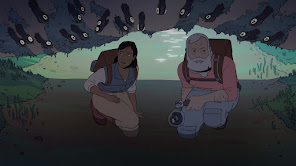As a side project to my space-based grief game, I want a small project to be able to demonstrate my artistic abilities in the specialism of concept art whilst still remaining relevant to the themes of pro-social gaming that the majority of my work and research has been geared toward. With this in mind, my aim is to look at various different neurological disorders as a descriptor to develop character concepts for - originally looking at a mobile game similar to Pokemon Go! with the idea of getting players outside and walking around as a therapeutic remedy to depression and other such conditions whilst also being a platform for information about conditions though I feel having no set format for the game would allow me to develop these characters based purely on my own artistic methodology and not being steered by mechanics of a game or rules thus showing off more of my own methodologies and what I'm capable of adding to a game developers art team.
Whilst there is an extensive list of these disorders there can be some creative freedom in looking at the symptoms and developing from there or merging certain conditions together that have close similarities to each other, this will be dependant on where my research and art development takes me.
The DSM, a classification and diagnostic guide published by the American Psychiatric Association, includes over 450 distinct definitions of mental disorders. Meanwhile, the ICD, published by the World Health Organization, stands as the international standard for categorizing all medical conditions, including sections on mental and behavioral disorders.
Revisions and updates are periodically made to the diagnostic criteria and descriptions in the DSM and ICD to reflect current understanding and consensus within the mental health field. The list includes conditions currently recognized as mental disorders according to these systems. There is ongoing debate among mental health professionals, including psychiatrists, about the definitions and criteria used to delineate mental disorders. There is particular concern over whether certain conditions should be classified as "mental illnesses' or might more accurately be described as neurological disorders or in other terms.
ANXIETY DISORDERS
Agoraphobia
Generalized anxiety disorder
Panic disorder
Selective mutism
Separation anxiety disorder
Specific phobias
Social anxiety disorder
DISSOCIATIVE DISORDERS
Dissociative identity disorder
Dissociative amnesia
Depersonalization-derealization disorder
Dissociative fugue
Ganser syndrome
MOOD DISORDERS
DEPRESSIVE DISORDERS
Depression
Anhedonia
Disruptive mood dysregulation disorder
Major depressive disorder
Dysthymia
Premenstrual dysphoric disorder
Psychotic depression
Seasonal affective disorder
Atypical depression
Catatonic depression
Postpartum depression
Melancholic depression
Pervasive refusal syndrome
BIPOLAR DISORDER
Bipolar I disorder
Bipolar II disorder
Cyclothymia
Hypomania
TRAUMA AND STRESSOR RELATED DISORDERS
Reactive attachment disorder
Disinhibited social engagement disorder
Post-traumatic stress disorder
Post-traumatic embitterment disorder
Acute stress disorder
Prolonged grief disorder
NEURO-DEVELOPMENTAL DISORDERS
Intellectual disability
Language disorder
Sensory processing disorder
Speech sound disorder
Stuttering
Aphasia
Autism spectrum disorder
Asperger syndrome
Rett syndrome
Attention deficit hyperactivity disorder
Developmental coordination disorder
Tourette syndrome
Down syndrome
Tic disorder
Dyslexia
Dyscalculia
Dysgraphia
Nonverbal learning disorder
SLEEP-WAKE DISORDERS
Insomnia
Hypersomnia
Idiopathic hypersomnia
Kleine-Levin syndrome
Narcolepsy
Sleep apnea
Night terrors
Exploding head syndrome
PARASOMNIAS
Nightmare disorder
Rapid eye movement sleep behavior disorder
Confusional arousals
Sleepwalking
Hypnagogic hallucinations
Hypnopompic hallucinations
CIRCADIAN RHYTHM SLEEP DISORDER
Delayed sleep phase disorder
irregular sleep-wake rhythm
Jet lag
Advanced sleep phase disorder
Non-24-hour sleep-wake disorder
NEURO-COGNITIVE DISORDERS
Delirium
Dementia
Traumatic brain injury
HIV-associated neurocognitive disorder
Amnesia
Chronic traumatic encephalopathy
Agnosia
SUBSTANCE-RELATED AND ADDICTIVE DISORDERS
All of the substances in this section of disorders have the same series of separate identifiers as follows;
Disorder
Dependance
Intoxication
Withdrawal
Delerium
Psychosis
Mood disorder
Anxiety
Addiction
Harmful pattern of use
All from the use of the following;
Alcohol
Cannabis
Synthetic cannabinoids
Opiods
Sedative, Hypnotic or anxiolytic
Cocaine
Amphetamines
Synthetic cathinone
Caffeine
Hallucinigens
Nicotine
Volatile inhalents
Dissociative drugs - ketamine, Phencyclidine etc
NON-SUBSTANCE RELATED DISORDER
Addictive personality
Gambling disorder
Video game addiction
Internet addiction disorder
Sexual addiction
Food addiction
Exercise addiction
Addiction to social media
Pornography addiction
Shopping addiction
PARAPHILIAS
Voyeuristic disorder
Exhibitionist disorder
Frotteuristic disorder
Pedophilia
Compulsive sexual behaviour disorder
Erotic target location error
Sexual masochism disorder
Sexual sadism disorder
Fetishistic disorder
Transvestic disorder
Other specified paraphilic disorder
SOMATIC SYMPTOM RELATED DISORDERS
Hypochondriasis
Cyberchondria
Somatization disorder
Conversion disroder
Factitious disorder imposed on self/or other (Munchausen syndrome/Munchausen by proxy)
Pain disorder
Medically unexplained physical symptoms
SEXUAL DYSFUNCTIONS
Delayed ejaculation
Erectile dysfunction
Anorgasmia
Vaginismus
Male Hypoactive sexual desire disorder
Female sexual arousal disorder
Persistent genital arousal disorder
Sexual arousal disorder
Premature ejaculation disorder
Dyspareunia
Sexual dysfunction
ELIMINATION DISORDERS
Enuresis
Nocturnal enuresis
Encopresis
FEEDING AND EATING DISORDERS
Pica
Pica
Rumination syndrome
Avoidant/restrictive food intake disorder
Anorexia nervosa
Binge eating disorder
Bulimia nervosa
Purging disorder
Diabulimia
Night eating syndrome
Orthorexia nervosa
Atypical anorexia disorder
DISRUPTIVE IMPULSE-CONTROL, AND CONDUCT DISORDERS
Intermittent explosive disorder
Oppositional defiant disorder
Conduct disorder
Antisocial personality disorder
Pyromania
Kleptomania
Mythomania
Disruptive mood dysregulation disorder
OBSESSIVE-COMPULSIVE AND RELATED DISORDERS
Obsessive-compulsive disorder
Body dysmorphic disorder
Body integrity dysphoria
Compulsive hoarding
Trichotillomania
Excoriation disorder
Body-focused repetitive behaviour disorder
Olfactory reference syndrome
Phantom limb syndrome
Primarily obsessional obsessive-compulsive disorder
Hoarding disorder
SCHIZOPHRENIA SPECTRUM AND OTHER PSYCHOTIC DISORDERS
Brief psychotic disorder
Delusional disorder
Delusional misidentification syndrome
Paraphrenia
Psychosis
Schizophrenia
Schizoaffective disorder
Schizophreniform disorder
Schizotypal personality disorder
Shared delusional disorder
PERSONALITY DISORDERS
CLUSTER A (ODD, ECCENTRIC)
Paranoid personality disorder
Schizoid personality disorder
Schizotypal personality disorder
CLUSTER B (DRAMATIC, ERRATIC)
CLUSTER B (DRAMATIC, ERRATIC)
Antisocial personality disorder
Borderline personality disorder
Histrionic personality disorder
Narcissistic personality disorder
CLUSTER C (FEARFUL, ANXIOUS)
CLUSTER C (FEARFUL, ANXIOUS)
Avoidant personality disorder
Dependent personality disorder
Obsessive-compulsive personality disorder
NOT OTHERWISE SPECIFIED (PD-NOS)
Depressive personality disorder
Passive-aggressive personality disorder
Sadistic personality disorder
Self-defeating personality disorder
OTHER
Gender dysphoria
Catatonia
Culture-bound syndrome
The end goal with this side project is to utilise the unique and intricate details of these neurological conditions with a deep dive into their histories, observing symptoms and explanations of them as a way to develop some sort of concept art depicting them as the demonic monsters they can be to the sufferers all whilst performing a representative and informative piece of work to be collated for viewers.


































